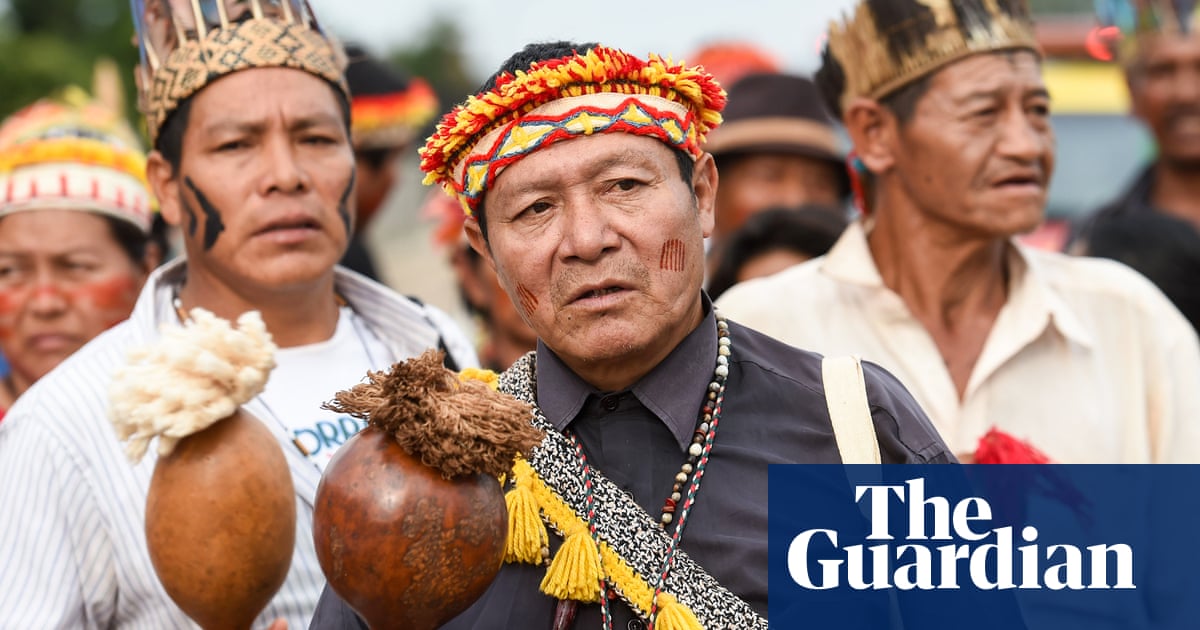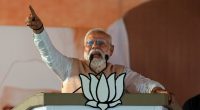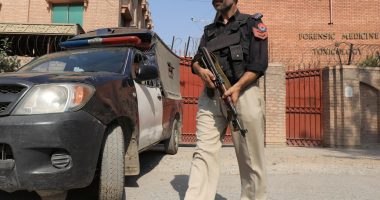
Brazil has issued its first-ever apology for the torture and persecution of Indigenous people during the military dictatorship, including the incarceration of victims in an infamous detention centre known as an “Indigenous concentration camp”.
The apology was made on Tuesday by an amnesty commission attached to the human rights ministry that is tasked with investigating the crimes of the 1964-85 regime.
The president of that commission, the law professor Eneá de Stutz e Almeida, knelt before the Indigenous leader Djanira Krenak as she voiced regret for the violence inflicted on the Krenak people.
“In the name of the Brazilian state I want to say sorry for all the suffering your people were put through,” said Almeida, who called the apology the first of its kind in the more than 500 years since Portuguese explorers reached what is now known as Brazil in 1500.
“In truth, I’m not saying sorry [only] for what happened during the dictatorship. I’m saying sorry for the persecution your people – as well as all other native people – have suffered over the last 524 years because of the non-Indigenous invasion of this land, which belongs to you,” Almeida told a hearing in the capital, Brasília.
Despite the scope of that declaration, Tuesday’s apologies concern two specific cases: one relating to the Krenak people from the south-eastern state of Minas Gerais and another relating to the Guarani-Kaiowá from Mato Grosso do Sul, towards Brazil’s western border with Bolivia and Paraguay. Indigenous leaders and historians say both groups were forced from their lands and brutalized by the dictatorship, which seized power after a coup d’état 60 years ago this week.
The Krenak have spent decades demanding justice for abuses committed against their people during a racist “re-education” campaign which the writer and activist Ailton Krenak said was designed to “rehabilitate” Indigenous people deemed “unfit for Brazilian life”.
How did it begin?
Brazil’s leftist president, João Goulart, was toppled in a coup in April 1964. General Humberto Castelo Branco became leader, political parties were banned, and the country was plunged into 21 years of military rule.
The repression intensified under Castelo Branco’s hardline successor, Artur da Costa e Silva, who took power in 1967. He was responsible for a notorious decree called AI-5 that gave him wide ranging dictatorial powers and kicked off the so-called “anos de chumbo” (years of lead), a bleak period of tyranny and violence which would last until 1974.
What happened during the dictatorship?
Supporters of Brazil’s 1964-1985 military regime – including Jair Bolsonaro – credit it with bringing security and stability to the South American country and masterminding a decade-long economic “miracle”.
It also pushed ahead with several pharaonic infrastructure projects including the still unfinished Trans-Amazonian highway and the eight-mile bridge across Rio’s Guanabara bay.
But the regime, while less notoriously violent than those in Argentina and Chile, was also responsible for murdering or killing hundreds of its opponents and imprisoning thousands more. Among those jailed and tortured were Brazil’s first female president, Dilma Rousseff, then a leftwing rebel.
It was also a period of severe censorship. Some of Brazil’s best-loved musicians – including Gilberto Gil, Chico Buarque and Caetano Veloso – went into exile in Europe, writing songs about their enforced departures.
How did it end?
Political exiles began returning to Brazil in 1979 after an amnesty law was passed that began to pave the way for the return of democracy.
But the pro-democracy “Diretas Já” (Direct elections now!) movement only hit its stride in 1984 with a series of vast and historic street rallies in cities such as Rio de Janeiro, São Paulo and Belo Horizonte.
Civilian rule returned the following year and a new constitution was introduced in 1988. The following year Brazil held its first direct presidential election in nearly three decades.
","credit":""}” config=”{"renderingTarget":"Web","darkModeAvailable":false}”>
Quick Guide
Brazil’s dictatorship 1964-1985
Show
How did it begin?
Brazil’s leftist president, João Goulart, was toppled in a coup in April 1964. General Humberto Castelo Branco became leader, political parties were banned, and the country was plunged into 21 years of military rule.
The repression intensified under Castelo Branco’s hardline successor, Artur da Costa e Silva, who took power in 1967. He was responsible for a notorious decree called AI-5 that gave him wide ranging dictatorial powers and kicked off the so-called “anos de chumbo” (years of lead), a bleak period of tyranny and violence which would last until 1974.
What happened during the dictatorship?
Supporters of Brazil’s 1964-1985 military regime – including Jair Bolsonaro – credit it with bringing security and stability to the South American country and masterminding a decade-long economic “miracle”.
It also pushed ahead with several pharaonic infrastructure projects including the still unfinished Trans-Amazonian highway and the eight-mile bridge across Rio’s Guanabara bay.
But the regime, while less notoriously violent than those in Argentina and Chile, was also responsible for murdering or killing hundreds of its opponents and imprisoning thousands more. Among those jailed and tortured were Brazil’s first female president, Dilma Rousseff, then a leftwing rebel.
It was also a period of severe censorship. Some of Brazil’s best-loved musicians – including Gilberto Gil, Chico Buarque and Caetano Veloso – went into exile in Europe, writing songs about their enforced departures.
How did it end?
Political exiles began returning to Brazil in 1979 after an amnesty law was passed that began to pave the way for the return of democracy.
But the pro-democracy “Diretas Já” (Direct elections now!) movement only hit its stride in 1984 with a series of vast and historic street rallies in cities such as Rio de Janeiro, São Paulo and Belo Horizonte.
Civilian rule returned the following year and a new constitution was introduced in 1988. The following year Brazil held its first direct presidential election in nearly three decades.
That campaign involved the incarceration of his people – and members of other Indigenous groups – in a prison-like “reformatory” on the banks of the Doce River. The rural “re-education camp” opened in 1969 – the most repressive moment of the 21-year regime – and received dozens of Indigenous inmates who were physically abused, exploited and forbidden from speaking their own languages.
The campaign also involved enlisting Indigenous people into a militia called the Rural Indigenous Guard whose members were trained in torture techniques. “It was a laboratory of utter terror … something abhorrent, like a horror film,” said Krenak, 70, who was a teenager at the time.
Krenak expressed hope that the commission’s apologies would pave the way for concrete reparations, such as land-based compensation to Indigenous groups stripped of their traditional territories. He predicted dozens more cases of dictatorship-era abuses would be examined over the coming years, many in the Amazon.
During the early years of the dictatorship – a period of rapid economic growth known as the “Brazilian miracle” – Brazil’s leaders unleashed a colossal infrastructure and development campaign in the rainforest region, bulldozing roads through remote jungles with scant thought for the Indigenous people who lived there. Disease and violence pushed previously uncontacted peoples to the brink of extinction.
“So many Indigenous lands were invaded during the Brazilian miracle, either by companies or government entities. It was a Brazilian miracle but an Indigenous disaster,” said Krenak, citing the devastation unleashed on the Waimiri Atroari people when a highway was built through their lands towards Venezuela. “They were annihilated by the army’s engineer battalion.”
Rubens Valente, the author of The Rifles and the Arrows, a seminal book about the dictatorship’s impact on Indigenous communities, said authorities needed to do far more to shed light on such cases.
“Indigenous people have told this story. Historians and researchers have told it. But the Brazilian state has not offered the explanations it should over what happened to Indigenous people and campesinos – let alone other minorities such as the LGBTQIA+ community, Afro-Brazilian quilombolas, the Roma people, and the Black community,” Valente said.
The Indigenous congresswoman Célia Xakriabá hailed the apology as a “historic day” she hoped would set a precedent for future claims, albeit one more than two decades in the making. (The amnesty commission was set up in 2002.) “[But] there’s no point in saying sorry if Indigenous rights continue to be violated. The wounds inflicted by the violence of the dictatorship have yet to heal and we are still coming under attack,” Xakriabá added, pointing to the 2015 Mariana dam disaster that poisoned the river flowing through Krenak lands with arsenic and mercury.
The apology came at a highly symbolic moment for victims of the dictatorship, when thousands of people were tortured or killed. Sunday marked the coup’s 60th anniversary and relatives of the dead had voiced anger at President Luiz Inácio Lula da Silva’s controversial decision to block official remembrance events – reportedly to avoid irking powerful military chiefs.
Krenak said he did not wish to judge Lula’s decision but believed remembering was essential.
“Dictatorship is a putrid thing. There are those who think dictatorship is about [good] governance. In fact, it’s about slaughter,” said the writer, who recently became the first Indigenous person to join the Brazilian Academy of Letters.
“Those who don’t remember the past are condemned to misery,” Krenak added. “If you don’t ensure new generations – those who are 20, 30 or 40 – know their country’s political history, then you are raising a nation of fools.”
Read More: World News | Entertainment News | Celeb News
Guardian







